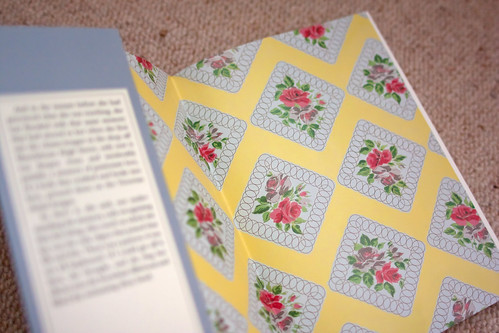This, which seems like time, must be instantaneous
The Victorian Chaise-longue
by Marghanita Laski
Almost exactly a year ago I went on what I hope will be the first of many trips to Persephone Books in London and, as well as being bought a book by my lovely friend H, I bought this book for myself on the back of several glowing reviews I had read around the internets. I can now add to all the glowing praise with some of my own!
This novella could well be described as sci-fi horror, but it’s both easier to read and more deeply soul-searching than that implies. It explores, through a deceptively simple story, questions about life, death, love, illness, pain, secrets and probably other things that I missed. (Simon of Savidge Reads wrote a fascinating review of this book that pointed out how it depicts the role of women in society.)
Melanie is a young, bubbly wife and mother recovering from a serious bout of TB in the 1950s. After being confined to her bed for eight months, she is thrilled when the doctor says she can be moved to another room, where she is lain on the Victorian chaise-longue, which she bought on a whim while pregnant but has never before been able to use. When she falls asleep in the afternoon, she wakes up in what appears to be not only another house but another time, almost a century earlier, in the body of someone called Milly, the only thing in common being the Victorian chaise-longue, or so she thinks at first.
“It must have been the chaise-longue, argued Melanie. There is no other link; something to do with Milly and the chaise-longue that was so powerful, that even I in the present, just by lying on it, couldn’t help but feel it…This, which seems like time, must be instantaneous, without duration or reality. But I seem real…”
I liked the way Laski dealt with time travel, answering some of the key questions that always come up with her own (possibly unique?) solutions. For instance Melanie can’t say anything out loud that doesn’t fit with the time and place – there’s a disconnect between what she intends to say and what comes out. But Laski also leaves Melanie to puzzle over some of the other time-travel issues, such as how the timeline works: has all this happened before? is this an alternative past? what is time doing in her present? She rejects outright the idea that this is a previous incarnation of herself, which leaves her with the creepy knowledge that if this is real, all the people she is interacting with, including Milly, are long dead in her own present.
“This body I am in, it must have rotted filthily, this pillowcase must be a tatter of rag, the coverlet corrupt with moth, crisp and sticky with matted moths’ eggs, falling away into dirty crumbling scraps. It’s all dead and rotten…She shuddered, and knew she was shuddering in a body long ago dead. Her flesh crawled away and it was flesh that had turned green and liquescent and at last become damp dust.”
I thought Melanie was a great character, full of life and realistic frustration that just as she is recovering from her near-death and is ready to enjoy her husband and child, she is spirited away to some puzzling situation in someone else’s past. She is at times a little too stiff and snooty, but then that’s a key part of the story – Melanie believes herself above these people she finds herself surrounded by, and that’s one of the obstacles she has to overcome to understand what’s going on.
It works brilliantly as a horror story because at first you think the only question is when will she get back to her own present, but then you gradually realise that the details of Milly’s situation mean there are other dangers here. It’s genuinely scary, which is not something I say often!
Marghanita Laski was a fairly well known member of the British literati who was nearly forgotten all too quickly, until Persephone Books republished this. They have subsequently picked out three more of Laski’s books for reissue. I am so grateful that there are outfits like Persephone out there preserving great literature for the future.
First published by the Cresset Press in 1953.
This edition published by Persephone Books in 1999.
